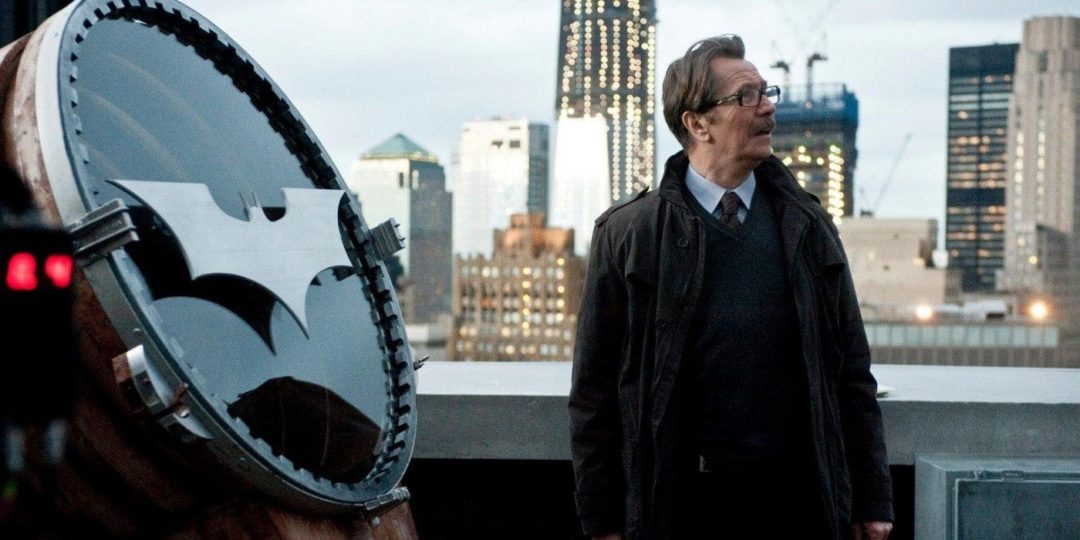In March of 2019, DC Comics and the world will be celebrating Detective Comics #1000 and the 80th anniversary of the debut of Batman. The Dark Knight isn’t the only one turning 80. Another member of the Batman universe also made his debut in the 1939 landmark issue: Commissioner James Gordon.
I am celebrating with him. Partnering with my local comic book store over the last few years I have been dressing up and cosplaying as Commissioner Gordon for events like Free Comic Book Day and Batman Day, handing out comics, taking photos, and hosting giveaways and trivia contests.
It started as a Halloween costume. My daughter wanted to be Batgirl that year. She asked if I was going to dress up too.”What would you like me to be?” I asked. “Well, you’re my dad, and I’m Batgirl, so you should be Jim Gordon!” She knew I had recently received an official Gotham badge, a gift from my local comic shop, for helping out with Batman Day festivities a month prior. A few days before Halloween, we attended Halloween ComicFest (an annual event like Free Comic Book Day) in our costumes. We had a blast as usual and I thought that was it. A few months later, I hooked up with the shop again to start planning the next Batman Day event and was met with a request from the owners: Could I cosplay as Commissioner Gordon for the store? They were excited about my look and thought it might bring in some people who would want pictures with me. I agreed and we started plugging my appearance.

It’s not a colorful look. A trench coat, a pair of glasses, a fedora, and, of course, a mustache. Put together though, it creates a visual as recognizable as pointy ears and a cape. Kids in line for free comics asked me if I knew the Batman and wanted selfies with “Batman’s best friend.” I was working the door at one event and from across the parking lot I heard a guy shout, “Is that Commissioner Gordon?” His excitement was palpable as he ran over to take some photos with me. He even wanted one of me arresting him against his car. The smile on his face was genuine, and I could feel the love for the character. My popularity with the crowd grew so much that when I had to skip some events due to health problems the shop received so many requests and questions about my return that they posted on social media to explain my absence. The support and encouragement from the community was humbling and exciting. Standing shoulder to shoulder with a cast of colorful characters, Jokers and Harleys, Wonder Women and Supergirls, I was struck with a question: Why was a mustachioed guy in a coat such a draw? What I found was a genuine attachment to who Gordon is and what he represents to Gotham City and to the Batman himself.
Appearing in the first panel of Detective Comics #27 in 1939 (well before the eponymous Batman himself), Commissioner Gordon was friends with wealthy socialite Bruce Wayne. He would feed Bruce information that could be useful to the Batman. Jim was distrustful of the Batman and his methods, but never concerned himself too much with stopping the errant vigilante. Jim served this narrative role for most of his early appearances in the comics. In the ‘50s and ‘60s, he evolved into more of a gatekeeper for Batman. He deputized the hero and called him into action when so called “archvillains” proved too much for the police to handle. He was the guy who lit the Bat-Signal.
Fans of a certain age remember him as portrayed by Neil Hamilton in the Batman television show from the ‘60s. His depiction was true to Gordon’s role in the comics up to that point, save for when Batgirl made her debut, but he was characterized in broad strokes due to the comedic nature of the show. By the late ‘70s and early ‘80s, when Denny O’Neil was changing what a Batman comic could be, Gordon’s characterization began to change as well. He was presented as a tired public servant, stressed by his role as top police officer.

Year One by Frank Miller and David Mazzucchelli ran in Batman #404-407 in 1987 and has come to be regarded not only as the definitive origin of Batman himself but also of Jim Gordon and their partnership in the fight for Gotham City. Equal time, if not more, is given to defining Jim as more than a gatekeeper or just the guy who calls the guy. He is established as a hero cop from Chicago who had some minor success against corruption before being transferred to his hometown of Gotham City. He is a man of integrity, with a clear understanding of and devotion to the law. But he is only one man in a sea of sharks. His portrayal as maybe the last good cop in Gotham imbues him with an aura of desperation,which in turn fuels the incongruous compromise he makes by working with a vigilante despite his belief in the law. It’s why it was such a revelation that Bryan Cranston was cast as Jim in the animated adaptation. The Breaking Bad star delivers a portrayal of a dedicated man wrestling with his righteousness in a world filled with shades of grey. Year One is revered for taking the most in-depth look at the formative years of Batman, but also its deconstructed examination of the origin of a partnership. It teaches us why Gordon lights the signal.
In the ‘90s, Jim appeared in Tim Burton and Joel Schumacher’s Batman films played by veteran character actor Pat Hingle. Save for a few standout scenes, it was clear the character was only in the films to tick the boxes of what should be in a Batman movie. (The same thing would happen again to J.K. Simmons in the Justice League movie.) On television though, Batman: The Animated Series was defining the visual and narrative structure of the world of Batman for a new generation. To this day, that show remains a high water mark in the history of these characters. The great radio actor Bob Hastings was the voice behind the Commissioner, and his character played a more integral role in the series. Like in the contemporary comics of the time, the show explored Jim’s relationship to Batman, Batgirl, and Gotham itself, establishing dynamics that continued to be pillars for the character’s mainstream portrayals. Hastings joined Kevin Conroy’s Batman and Mark Hamill’s Joker in establishing the voices we heard when we read comics. At least until 2005.
Gary Oldman steals the show in Batman Begins. Known for his portrayals of arch, sometimes over the top antagonists, Oldman turns in a revelatory performance of the character. It’s a master class in playing against type. He adds a melancholy to Jim, elevating the sense of hopelessness he feels. He plays every emotion grounded, which is encapsulated with his line “You’re just one man?” He displays a surprising, incrementally rising glimmer of hope when he hears Batman’s answer to that question: “Now we are two.” Inspired by Year One, Batman Begins delves into the origin of the partnership while adding a wonderful new wrinkle to the mythos: that Jim was there when the Waynes were killed. While all others were concerned about catching the murderer, it was Jim who reached out to the young Bruce Wayne to let him know the world hadn’t ended. It seeds what would become the mission statement for the entire Christopher Nolan trilogy: that a hero can be anyone. Their dynamic provides the true emotional crux of the film, culminating with their final exchange,” “I never said thank you,.” says Jim. “And you’ll never have to,” Batman responds.

I would be remiss if I didn’t mention Gotham. I love this show despite the vitriol it has received from certain corners of the internet. Ben McKenzie gives a balanced nuance and freshness to Jim that could only be delivered in a TV format. But what strikes me about this show, and its relevance to the character’s legacy, is the accessibility it has by virtue of being being a primetime network show. Many families I’ve taken pictures with have mentioned that they all watch the show together. Children who weren’t old enough or even alive for the phenomenon that was The Dark Knight are now excited and engaged with this mythology. A whole new generation of fans have been exposed to our favorite fictional city and its citizens. To me that’s more important than the “canonical” criticism anyone can throw at Gotham.
Batman’s earlier life is defined by finding surrogate family figures. Bruce was trained by a myriad of would-be fathers and mothers all over the world. What Jim Gordon represents to Batman, and us, is most evident in this particular role. Most people reach a moment in life when their first real adult decision has to be made. We turn to our parents for council to ask, even metaphorically, is it OK to be an adult now? Is it OK to make this decision on my own? It’s this context that defines who Jim is to Bruce. He gives Bruce permission to make this crazy, life-altering decision. The permission to make this sacrifice. The permission to plunge his hands into to the filth so Jim could keep his clean and remain the one good cop left in Gotham.
That’s what I see in the eyes of fans who get excited when I cosplay for events. The reverence for the guy who lights the signal. The appreciation for the man who lets Batman be Batman. The respect for a hero who does something as small and reassuring as putting a coat around a small boy’s shoulders to let him know the world hadn’t ended. The admiration for the adult in the room.






Published: Mar 8, 2019 09:00 am